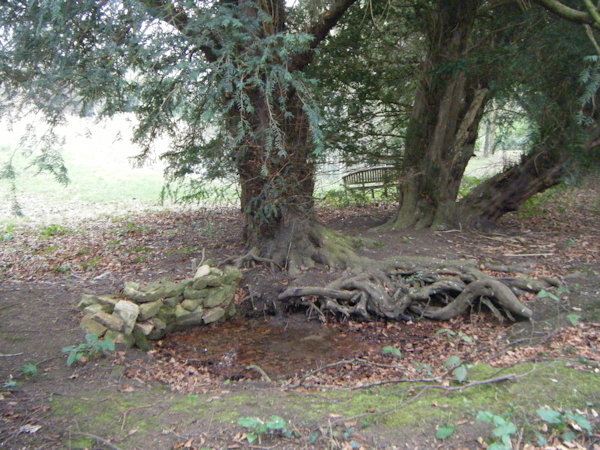 |
Dedication: Saint Peter Location: Rushton Hall Coordinates: 52.43303N, -0.77061W Grid reference: SP836823 Heritage designation: Grade II listed building |
HOME - ENGLAND - NORTHAMPTONSHIRE
 |
Dedication: Saint Peter Location: Rushton Hall Coordinates: 52.43303N, -0.77061W Grid reference: SP836823 Heritage designation: Grade II listed building |
There was once a church dedicated to St Peter in the grounds of Rushton Hall, one of two churches in Rushton, which was formerly divided into two separate parishes. This church was demolished in 1785, and no trace of it can now be seen. Almost certainly, however, water from St Peter's Spring would have been carried to this church for baptisms, and this undoubtedly gave it its name.
The fact that St Peter's Spring emerges from beneath the roots of not one but two old yew trees indicates that the well's "holiness" dates from at least the medieval era, but probably from even earlier. The earliest known reference, however, to the site's existence does not even mention the well's dedication to St Peter, but instead calls it the "Nine Springs". For this reason, it has been suggested that the well may have become known as St Peter's after the demolition of the parish church, but to me this seems very unlikely. Instead, I think that it more probable that the well simply had more than one name (like many holy wells); perhaps the more secular one, "Nine Springs", was preferred after the Reformation. This early reference dates from 1712, and can be found in John Morton's Natural History of Northampton-shire, in which the site is actually mentioned twice. Morton implied that the spring had very recently been converted into a sort of bath-house or folly:
|
About Four Miles Diſtance from its [the River Ise's] Source, betwixt Desborough and Ruſhton, it takes in a plentiful Spring running down from Ruſhton Park, by the Name of Nine-Spring-Head, as being a Collection of Nine little Springs which guſh forth, it's ſaid, at as many diſtinct Apertures, within a ſmall Compaſs of Ground, and are now drawn into a Stone Baſin over which a handſome Summer Houſe was built, by the late Lord Cullen. |
The second time that Morton mentions the site identifies its location, and proves that he was indeed referring to St Peter's Spring. In a section of his book that speaks of the "Incruſtations of our Brooks and Rivers", he relates that "when there was no artificial Chanel for the Water of the Nine Springs, in the Summer-Houſe in Ruſhton Park there were many Incruſtations there", before going on to assert that there is a mill, "about Two or Three Hundred Yards below" the well. St Peter's Spring does in fact feed the River Ise (as Morton described), which, a few hundred yards downstream, goes on to supply the now disused Shotwell Mill. Certainly, then, the current bath-house is not the first on the site.
Probably in the early 19th century, or the late 18th, this older "summer-house" was replaced, or at least remodelled (it is quite possible that the main fabric of the baths remain unchanged). What makes this clear is not in fact documentary evidence, but one of the many inscriptions that can be seen on the walls of the bath-house. This particular inscription is situated directly opposite the doorway, above a large recumbent stone figure, and it is a verse taken directly from one of the poems of Thomas Warton, who became the Poet Laureate in 1785. He died in 1790, and it is probably after this date that the inscription was added to the bathing house. This inscription was transcribed and translated in 1896 in Rushton and its Owners:
|
Hujus Nympha loci, sacri Custodia fontis, Translation: Nymph of the spot, this sacred font I keep, |
This clearly refers to the large recumbent stone figure beneath it, indicating that the statue was deliberately made into a feature of the bath-house when it was remodelled. However, this figure clearly was not originally made for the bath-house, and it seems to be much older than it, as it is missing its left arm. Interestingly, the discovery of several stone figures near the bath-house was mentioned in Rushton and its Owners:
|
In about 1848, during the remodelling of a portion of the grounds, a quantity of sculptured fragments were dug up in the vicinity of the bath. Faith, Hope, and Charity, figures that probably at one time decorated the formal garden of the 17th century, were easily distinguished. The chief pieces were kept above ground until the frost and other agencies destroyed them. The rest were covered over again. |
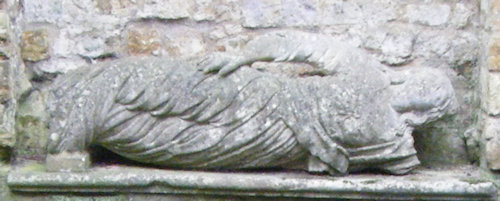 |
It is quite possible that one of the statues that was discovered was transferred to the bath-house, to become a sleeping nymph. This would date the remodelling of the bath-house to shortly after, or during, 1848, which perhaps coincides with "the remodelling of a portion of the grounds". A poem that was written by George Edmond Maunsell in around 1856, entitled "Rushton Hall", indicates that the remodelling of the bath-house had been a recent occurrence (adding to the evidence that the baths may have been significantly altered in around 1848):
|
The mount is levelled, Hercules |
This new, re-modelled bath-house is reputed to have once possessed a glazed roof, and, in 1896, two "posts with iron staples", to which chains were once attached (they seem to have served as handrails), were still visible in the water. An illustration of the bath-house was included in Rushton and its Owners that showed it "falling to decay":
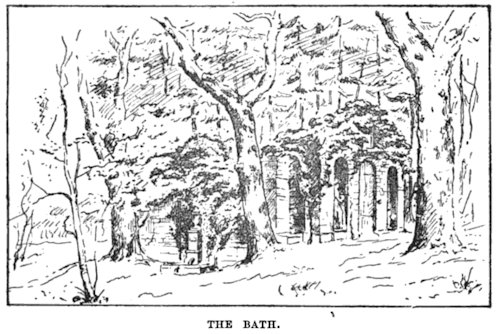 |
The site was restored in 2001 (according a stone plaque on the building's south wall), and it may have been then that the "posts with iron staples" were removed, possibly if they had begun to rot.
The most intriguing part of the entire site, however, is the spring that still exists to the south of the bath-house. As this spring emerges beneath two yew trees, there is no doubt that this is the original St Peter's Spring. (The main image above is of this spring.) When I visited the site in the March of 2025, this spring was producing a copious amount of water, although none of it seemed to be feeding the bath, which was only filled with a small amount of stagnant rainwater.
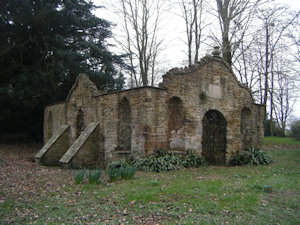 |
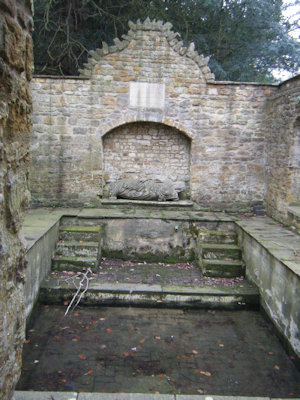 |
|
Access: The well is located on private land in the grounds of Rushton Hall. |
Copyright 2025 britishholywells.co.uk